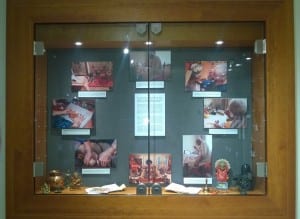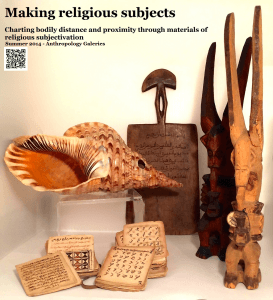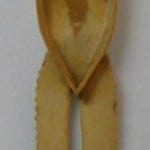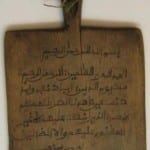Making Religious Subjects: Charting bodily distance and proximity through materials of religious subjectivation – Summer exhibition on display

The exhibition on display in the Anthropology Galleries shines light on the relationship between religious bodily practice and material culture in association with The Bodily and Material Culture of Religious Subjectivation conference (17-18 June 2014).
The large showcase contains artefacts from the Ethnographic Collections and aims to explore an understanding of religion based on exchange, particularly material-bodily exchanges with the immaterial, or invisible. Through transformations of bodies and subjects, objects play a part in the mediation of particular exchanges with gods or ancestors.
Here are some examples of the objects on display:
This kind of spoon was the emblem of the two highest levels of the Bwami society.
This spoon was used to symbolically ‘feed’ masked dancers during their performances.
The first Sura is written on both sides of the Prayer-Board.
Prayer-boards were used by students to help them memorise Koranic verses or in response to supplicants’ problems and requests. The ink was washed off and the water was then believed to contain the words of God and was at times used to ward off illness.
Ikenga comes from ‘i-ke’, meaning strength or power, and “n-ga”, meaning place or location. As a domestic divinity, the Ikenga is expected to strengthen and reinforce its owner. The basic form of an ikenga is a human figure with horns symbolising power, sometimes reduced to only a head with horns on a base.
Worn by initiated young men to indicate their level of status within the community, an embellished and larger belt would reflect a higher position in the hierarchies of age and knowledge.

Carved body belt
Papau New Guinea, Elema people (?)
Tree bark, white pigment
UCL Ethnography collection, J.0046
In the second showcase, we explore a more personal, everyday and practical-minded depiction of the ritual creation of religious subjects through bodily engagement with the material world. These photographs depict the co-curator’s own grandparents, Kundanbala and Ravishanker Joshi, perform their morning puja at home – a sequence of prayers, offerings and evocations to worship deities, express devotion and ultimately reiterate their religiosity through regular, ritual subjectivation.This exhibition will remain on display until the beginning of August.


Curators: Elizabeth Fox, Priya Joshi, Delphine Mercier
Conservator: Nora Frankel
Exhibition Curatorial Note
We would like to thank all staff and students for their hard work, especially Susie Chan and Dave Bellamy (UCL Museums and Collections Exhibitions team). We are also grateful to the Anthropology Department and to The Bodily and Material Culture of Religious Subjectivation conference (Urmila Mohan and Jean-Pierre Warnier) for their support.




Congratulations to the collections team! Like many others I was pleasantly surprised at the quality of artifacts (condition and rarity) that we have in our collection. Also, it was a genuine pleasure to work with Delphine, Liz and Priya. The display provided a great counterpoint to the conference and acts as a lovely reminder of the event afterward.